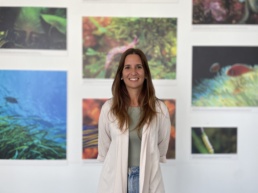An ambitious, innovative, and demanding project from a researcher at Porto University will allow the measurement of the impact of climate change on both coasts of the North Atlantic.
More than 2000 sensors installed on 85 beaches along the Atlantic Coast will measure the water temperature from Guinea-Bissau to Norway, through Iceland and Greenland, to the Arctic, and from there along the West Coast to Ecuador.
The CIBIO-InBIO researcher at Porto University, Rui Seabra, won the FLAD Science Award Atlantic to develop this project that can change our global perception of the Atlantic.
“Global warming is unfolding and everything indicates that it will accelerate in the next decades. An important aspect, which is increasingly clear, is that this warming is not uniform. And especially in coastal areas, we have been detecting important differences in warming rates from place to place”, says Rui Seabra.
The project, which will be developed in collaboration with three researchers from North-American universities, foresees the installation of sensors in the rocks by the sea on these 85 beaches.
Until now, data on water temperature had been collected via satellite. However, satellite data does not have enough resolution to analyze the temperature near the coast, because it captures a part of the earth, thus contaminating the data.
The researcher at Porto University found that the error in the water temperature indicated by satellites next to the Coast of Portugal was considerable and created a more reliable system.
“Satellite data has a nuance: It is much easier to measure the temperature of the water in high seas than in the sea near the coast, because along the coast the satellite captures part of the earth, and contaminates the data. This error is not a systematic error, it is not the same everywhere. But in Portugal the error is substantial”, explains the researcher.
With this project, Rui Seabra will be able to install the new sensors across the North Atlantic Coast, allowing researchers to know the water temperature in these areas and where the satellite data is not correct.
“For the first time we will be able to validate the full scale of the North Atlantic and see where we know that satellite data is reliable, and where it is not, and warn researchers not to use it,” he explained.
Technological and methodological innovation
The scale of this work is one of its most important features, but it is not the only one. The researcher developed the technology to ensure easier and more reliable data transmission, allowing for a longer lifetime to be given to the project.
The sensors will now be installed directly on the rocks, with a drill, which will prevent loss of sensors and data by theft or by the destruction caused by waves.
“What is proposed is the implementation of a network for monitoring the temperature and coastal biodiversity that, when implemented, will be the largest of its kind in the world.”
In addition to how they will be installed, the new technology will allow data transmission to be done through contactless technology, that is, a person only needs to approach the sensor with a phone to collect the data, which is automatically transmitted to the researcher.
“What exists today is equipment that requires the connection of cables to download directly on a computer. These are more complex processes, difficult to explain to people who are not 100% invested in the same area”, he explained.
With this new technology, the process will be able to be continued more simply over time, even if the researchers involved in the data collection leave the project.
The sensors will also be more resilient and efficient with this new technology, which will make the losses over a decade – the expected duration of the project – the same as the researchers suffered in just one year of using the old technology.
Large-scale work with practical results
The data that will be collected by researchers will also allow the comparison of sea temperature and the impact on key species individually.
“It’s not just increased coverage, there’s a whole set of questions that are being answered and that could only be answered on large scales,” explains the researcher.
This means that it will be possible to distinguish what are normal signs of progress and setbacks for certain species, due to the consequences of temperature changes.
The researcher also says that these data will provide answers to questions posed by the Intergovernmental Panel on Climate Change of the United Nations with a much greater degree of confidence than possible so far.
Congratulations Rui Seabra and good work!
Related Posts
17 de February, 2025
Launch of the FLAD Rui Machete Award: 200 thousand euros to distinguish paths of excellence in the Portugal-USA relationship
The Award, worth 200 thousand euros,…
14 de January, 2025
New R&D@USA Scholarship Holders 1st semester 2025
FLAD has already selected candidates…
13 de December, 2024
Vânia Baptista, from the University of Algarve, wins FLAD Science Award Atlantic 2024
The project 'Finding Home – Discovering…


